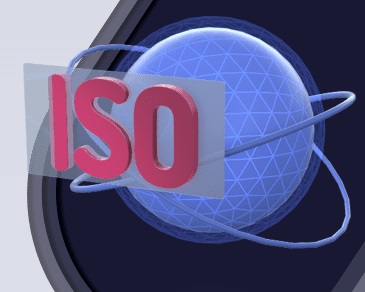ISO 27001 vs. PCI DSS: Choosing the Right Framework
Unsure whether ISO 27001 or PCI DSS is right for your business? Learn how to choose the best framework to enhance your security and compliance efforts.
Published April 10, 2025.

Choosing the right security framework for your business can be challenging, especially when deciding between ISO 27001 and PCI DSS. Both frameworks offer valuable tools for protecting data, but selecting the right one depends on your organization’s specific needs and objectives. Whether you're aiming for broad organizational security or focused compliance around specific data types, it's essential to understand how each standard aligns with your goals.
In this blog, we'll help you evaluate the factors that can influence your decision, ensuring that your business stays secure and compliant.
» Let GRSee help you choose the right framework for your business: Contact us
Overview of ISO 27001 and PCI DSS
ISO 27001
ISO 27001 is an international standard for establishing and maintaining an information security management system (ISMS). It applies to any organization, regardless of industry, size, or business model, providing a flexible framework for managing security risks.
It is widely adopted across various sectors, including:
- Finance
- Healthcare
- Government
- Technology
Organizations seeking to improve their security posture or demonstrate compliance with regulatory requirements often implement this standard.
The objective of an ISMS is to ensure the confidentiality, availability, and integrity of information assets through a systematic approach that incorporates:
- Risk management
- Compliance efforts
- Continual improvement
» Here's everything you need to know about the importance of ISO 27001
PCI DSS
PCI DSS (Payment Card Industry Data Security Standard) is a comprehensive set of security standards designed to protect payment card transactions and ensure the security of sensitive cardholder data throughout the payment process.
It applies only to organizations that process, store, or transmit cardholder data, such as:
- Banks
- Fintech companies
- E-commerce businesses
- Payment processors
The security standards of PCI DSS cover sensitive payment data, including the primary account number (PAN), cardholder name, expiration date, and service code. It also protects authentication details like magnetic stripe data, CVV codes, and PINs. Any entity involved in handling this information must comply with PCI DSS to prevent fraud and security breaches.
The objectives of PCI DSS are guided by 6 principles:
- Build and maintain a secure network and systems
- Protect cardholder data
- Maintain a vulnerability management program
- Implement strong access control measures
- Regularly monitor and test networks
- Maintain an information security policy
» Keep these PCI DSS myths in mind
Risk Management in ISO 27001 and PCI DSS
ISO 27001 Approach to Risk Management
ISO 27001 takes a holistic approach to risk management, covering the entire organization from clauses 4 (context of the organization) to 10 (continual improvement effort). It applies 93 controls to safeguard information assets, ensuring confidentiality, integrity, and availability (the CIA triad).
Organizations have flexibility in implementing controls as long as they align with security objectives. The methodology follows the PDCA (plan-do-check-act) cycle.
Risk assessment and compliance:
- Risk assessments can be conducted by internal or external auditors.
- Certification requires an external audit by an ISO 27001 lead auditor.
- Organizations with minor nonconformities can still be recommended for certification if they commit to addressing them before the next audit cycle.
» Here's what you should know before hiring a risk assessment provider
PCI DSS Approach to Risk Management
PCI DSS focuses specifically on risks related to people, processes, and technology within the cardholder data environment. It provides two compliance paths: the defined approach, which enforces strict security controls, and the customized approach, which allows flexibility but requires a mature security posture.
Risk assessment and compliance:
- Compliance assessments must be conducted by a Qualified Security Assessor (QSA) from a PCI QSA company.
- The assessment process includes a gap analysis, remediation efforts, and certification readiness.
- Full compliance with all applicable PCI DSS requirements is mandatory for certification.
Take note: Whether you're seeking compliance with ISO 27001 or PCI DSS, it's important to have risk owners in place with clearly assigned responsibilities within the scope of the assessment. Additionally, timelines should be established to address and remediate identified risks.
Certification Process and Compliance Steps for ISO 27001 and PCI DSS
ISO 27001 Certification Process
ISO 27001 follows the PDCA (plan-do-check-act) approach and consists of two audit stages:
Stage 1 audit:
- The organization's documentation is thoroughly reviewed against each requirement in the standard to ensure that all processes are properly documented, communicated, and approved.
- Can be conducted physically, remotely, or using a hybrid approach.
Stage 2 audit:
- The effectiveness of the documented processes is validated to ensure that the organization follows the right practices.
- Can be conducted through interviews with process owners or on-site assessments.
Take note: The ISO 27001 certification process requires that the external audit be conducted by an Accredited Certification Body while the internal audit for ISO 27001 could be done by qualified internal resources from the internal audit department or contracted to a consultant for proper hand-holding.
» Need more guidance? Check out this guide on how to become ISO 27001 compliant
PCI DSS Certification Process
The audit process for PCI DSS must be conducted by a QSA who has been certified by the Payment card industry security standards council (PCI SSC) and the qualified security assessor must be working with a PCI QSA Company who has a valid license and in good standard with PCI SSC.
The activities of the QSA pass through these 3 stages:
- Scope Definition: Define the cardholder data environment and confirm the scope early to avoid scope creep and reduce compliance overhead.
- Gap assessment: The QSA works with the organization to define the assessment scope across people, processes, and technology, identifying security gaps.
- Gap remediation: The organization implements measures to fix the identified gaps and improve its security posture concerning cardholder data protection.
- Certification readiness: Ensures that all PCI DSS requirements are met before the formal assessment.
Assessment outcomes:
- If all requirements are met, the entity receives a Report on Compliance (ROC) and an Attestation of Compliance (AOC) signed by the QSA.
- If the entity does not meet all requirements, it receives a report of non-compliance with a remediation date to address the gaps.
- Level 1 merchants receive ROCs, while merchants and service providers below this level receive self-assessment questionnaires (SAQs).
» Discover the key success factors of PCI DSS compliance
Business Suitability and Industry Considerations
When deciding between ISO 27001 and PCI DSS, businesses need to evaluate several factors to determine which framework aligns best with their operations and compliance needs. These factors include:
- Business type: Organizations that process, store, or transmit cardholder data—such as banks and payment processors—must comply with PCI DSS. Meanwhile, companies focused on general information security, including IT firms and data privacy organizations, may find ISO 27001 more relevant.
- Future market opportunities: Expanding into new markets may require specific certifications. For example, working with enterprise clients often necessitates ISO 27001, while e-commerce businesses handling payments must meet PCI DSS requirements.
- Regulatory requirements: Certain industries have mandatory compliance obligations. Financial institutions, for instance, are typically required to follow PCI DSS, while ISO 27001 may be needed for broader information security compliance.
- Overall compliance needs: Organizations should assess whether their security goals align more closely with PCI DSS’s focus on cardholder data protection or ISO 27001’s broader approach to information security management.
» Need more help? Here's how to build a robust PCI DSS security strategy
Is There a Need for Both Certifications?
Pursuing both certifications may be necessary for businesses that operate in industries where both frameworks apply. Situations that may require both include:
- Companies that handle both cardholder data and other types of sensitive information.
- Businesses that need to meet the compliance requirements of multiple clients or regulatory bodies.
- Organizations that want to strengthen their overall security posture and market credibility.
- Cases where noncompliance could lead to financial penalties, operational restrictions, or reputational harm.
How GRSee Consulting Can Help
When deciding between ISO 27001 vs. PCI DSS, it's important to understand your business’s specific needs. At GRSee Consulting, we can help you determine which framework aligns with your operations and regulatory requirements.
Our experts will work with you to evaluate your current security practices and identify the best approach. Let us help you navigate these decisions and strengthen your security posture. With our support, you can confidently achieve compliance and enhance your business’s security strategy.
» Contact us, and we’ll help you navigate between ISO 27001 and PCI DSS to find the right framework for your business

